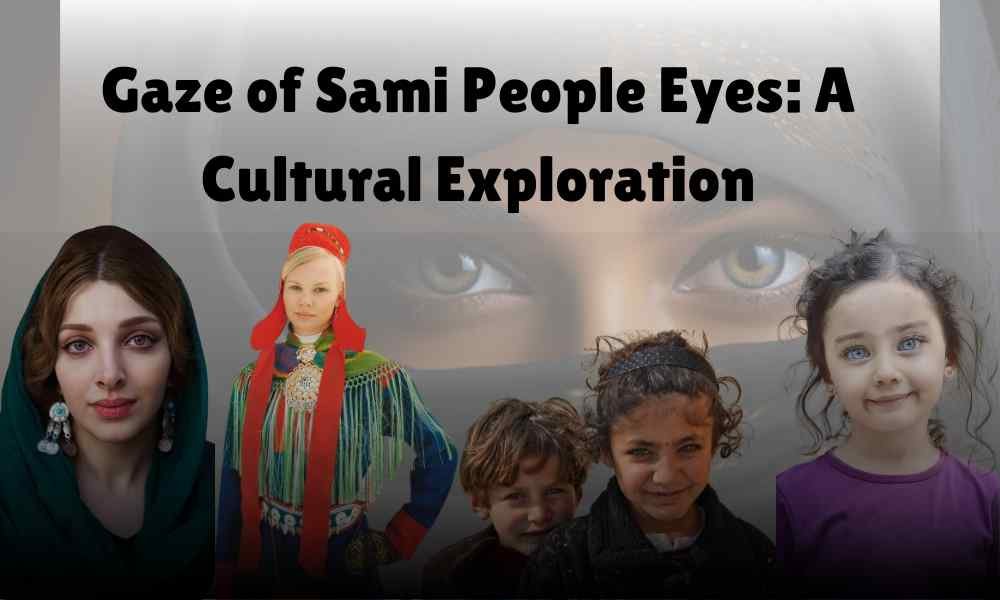The Sami people eyes are the indigenous inhabitants of Sápmi, a region that spans Norway, Sweden, Finland, and Russia. The Sami people eyes are a striking feature, often described as mesmerizing or otherworldly. However, these eyes hold a cultural significance that goes beyond their aesthetics. In this article, we will explore the captivating world of Sami eyes and the stories they tell.
The Genetics Behind the Beautiful Spectrum of Sami People Eyes:
Sami eye color come in a breathtaking range of colors, including icy blues, warm ambers, and mesmerizing greens. Hazel eyes with flecks of gold are also prevalent.A combination of genetic factors and historical interactions with neighboring populations attributes to this diversity.
Beyond Physical Beauty:
The cultural significance of Sami eyes goes far beyond physical attractiveness. Traditionally, the Sami believed that the sami eye color were windows to the soul, reflecting a person’s inner spirit and connection to the natural world.
Eyes as Mirrors of the Soul:
The clarity and brightness of Sami’s eyes were seen as indicators of their character. Clear, bright eyes signified honesty, purity, and a strong connection to the spirits of the land. Conversely, dull or bloodshot eyes might suggest illness or inner turmoil.
Connection to Nature:
The Sami people eyes have a deep respect for nature, and their eyes are often likened to the colors of the natural world – the icy blue of glaciers, the deep green of pine forests, or the warm amber of a summer sunset. This connection reflects the Sami belief in their interdependence with the environment.
Cultural Expressions of sami people eyes :
The Sami people have captivating eyes that hold a depth beyond physical beauty. Their eyes reflect their culture in various ways. Moreover, beyond just using specific eye colors in art forms, here’s a deeper exploration of this cultural expression:
Symbolic Meanings:
- Connection to Nature: The Sami people eyes holds a deep reverence for nature, and their eye colors are often likened to the natural world’s elements. Bright blue eyes might mirror the glacial skies, while warm amber hues could reflect the colors of a summer sunset. This connection symbolizes their deep interdependence with the environment.
- Reflections of the Soul: Traditionally, the Sami believed eyes were windows to the soul. Clear, bright eyes signified honesty, purity, and a strong connection to the spirits. Conversely, dull or bloodshot eyes might suggest illness or inner turmoil. This belief system associated eye appearance with a person’s character and well-being.
Storytelling and Language of Sami people Eyes:
- Metaphors and Descriptions: The Sami language includes metaphors or sayings that refer to eye color.For example, people might describe someone with deep green eyes as having “eyes like a mountain lake,” while they might represent someone with bright blue eyes as having “eyes that sparkle like the northern lights.” These expressions establish a link between physical appearance and the natural world, which is significant in Sami culture.
- Character Descriptions: Sami storytelling traditions might describe characters with captivating eyes, hinting at their personality or destiny. A character with piercing blue eyes could embody courage and wisdom, while someone with gentle, warm brown eyes might represent compassion and kindness. These descriptions associate eye color with specific traits and roles within the narratives.
Jewelry and Traditional Dress For Sami People Eyes:
- Symbolic Colors: Traditional Sami jewelry and clothing sometimes incorporate colors that mirror the colors of Sami eyes. Beadwork on clothing or intricate patterns on jewelry might utilize blues, greens, and ambers, reflecting the wearer’s own eye color and potentially serving as a form of personal expression or cultural identity.
Modern Expressions:
- Photography: Contemporary photographers are drawn to capture the depth and emotion conveyed by Sami eyes. These photographs can serve as a powerful way to showcase Sami beauty and cultural identity in a modern context.
Cultural expressions are constantly evolving and changing. As the Sami people continue to navigate the contemporary world, new forms of expression may emerge, which may reference eye color. For example, Sami artists may incorporate colors associated with Sami people eyes into their paintings or digital art.
The Unique Beauty of Sami Eyes
The captivating beauty of Sami eyes never fails to draw attention. Indigenous to northern Europe, the Sami people often possess remarkably bright blue or green eyes that contrast beautifully against their traditionally tanned skin. These unique eye colors are a product of the Sami’s genetic heritage and their centuries-old natural environment, making them truly mesmerizing and one-of-a-kind.
Looking Beyond the Eyes:
The eyes of the Sami people are a beautiful and culturally significant feature, but it’s crucial that we appreciate them within the context of their rich cultural heritage.A vast array of traditions, stories, and beliefs comprise their culture, extending far beyond a single physical characteristic and deserving recognition.
Eyes in Sami Art and Storytelling
Eyes play a significant role in Sami art and storytelling.In traditional Sami culture, artists often depict eyes to symbolize wisdom and spiritual insight. Stories passed down through generations highlight the mystical power of eyes, reflecting the deep connection between the Sami people and their natural surroundings. This focus on eyes in their cultural expressions emphasizes the importance of vision and perception in Sami heritage.
Respectful Appreciation:
When discussing the cultural expressions of the Sami people eyes, it’s important to maintain a respectful and inclusive approach. Here are some key points to consider:
- Diversity Within Sami Culture: The Sami people eye are a diverse population with their own unique stories and traditions.The Sami community exhibits variations in eye color, so we shouldn’t assume that everyone has the stereotypical “ice blue” eyes.
- Focus on the Whole Culture: While eye color holds significance, it’s just one facet of their rich cultural tapestry. Appreciate their language, storytelling traditions, art forms, and connection to nature for a more holistic understanding.
Modern Interpretations of sami people eye:
The captivating gaze of the Sami people still holds a certain mystique in today’s world. Photographers are often drawn to capture the depth and emotion conveyed by their eyes. However, it’s important to remember that the Sami people are a diverse population with their own unique stories. Although their eyes are a beautiful and culturally significant feature, they should not overshadow the richness of their culture, traditions, and resilience.
The Significance of Eyes in Sami Culture:
Sami people eyes culture regards eyes as windows to the soul, imbued with deep spiritual and symbolic meaning. The mesmerizing gaze of the Sami people is said to convey wisdom, resilience, and a profound connection to nature and the spirit world. Through their eyes, the Sami express their deep-rooted connection to their land, traditions, and ancestral heritage.
Cultural Practices and Beliefs:
The Sami people eyes have a rich oral tradition and storytelling culture, where myths, legends, and folklore are passed down through generations. Many stories highlight the importance of the eyes as conduits for spiritual insight and intuition. In Sami mythology, the shamanic tradition plays a central role, with shamans believed to possess the ability to see beyond the physical realm and communicate with the spirit world through their eyes.
Artistic Expressions of sami people eyes:
Art and craftsmanship are integral to Sami culture, seen in traditional crafts like duodji, which reflect nature’s beauty and symbolism. Sami artists depict their people’s mesmerizing gaze in paintings, sculptures, and more, capturing their cultural identity’s depth and complexity.
Cultural Preservation and Revival:
The captivating eyes of the Sami people are a treasure, but true cultural preservation goes beyond physical appearance. Here’s how the Sami people are safeguarding and revitalizing their rich heritage:
Revitalizing Languages:
- Language Courses and Educational Programs: Sami languages, once threatened by extinction, are experiencing a revival. Sami communities are offering language courses, integrating Sami languages into school curriculums, and developing educational resources to ensure younger generations can learn and speak their ancestral languages.
- Sami Language Media: Sami language radio stations, TV channels, and online publications are flourishing. This creates a platform for Sami voices to be heard, stories to be told, and cultural knowledge to be transmitted in their own languages.
Passing Down Traditions:
- Intergenerational Knowledge Sharing: Elders are essential for passing down traditional knowledge. This includes storytelling, crafts such as reindeer herding, clothing making, and beadwork techniques. Cultural centers and workshops facilitate knowledge transfer.
- Reviving Traditional Practices: Traditional practices like Sami yoiking (a form of singing), joik performances (songs about people, places, and animals), and seasonal celebrations are being actively revived. This keeps cultural traditions alive and fosters a sense of identity among Sami youth.
Conclusion:
The captivating gaze of the Sami people provides a window into their unique and resilient culture. Through active efforts to revive their native languages, traditions, and art forms, the Sami are safeguarding their cultural heritage for future generations. By comprehending and appreciating these preservation efforts, we can celebrate the richness of Sami culture and advocate for its continued flourishing.
Overall, understanding the preservation efforts of the Sami people is crucial in promoting cultural diversity and recognizing the value of cultural heritage. By acknowledging and celebrating the richness of Sami culture, we can promote cross-cultural appreciation and foster mutual respect.



